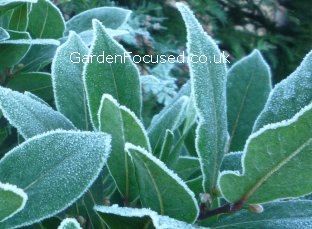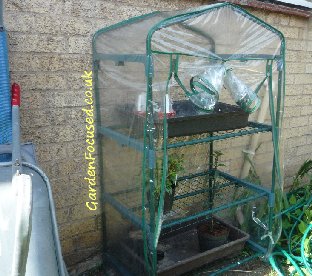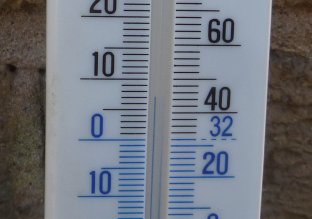PROTECTING BAY TREES FROM FROST
Article by David Marks
The frequently given advice concerning bay trees and frost damage is that they will withstand temperatures down to -5°C (23°F) without significant damage. As far as short and sharp advice is concerned that’s about correct but it is by no means all the story. We investigate this subject in depth and use our extensive practical experience to suggest some of the methods you can use to protect your bay tree from frost damage.
PROTECTING POT GROWN BAY TREES
Bay trees grown in pots are more prone to frost damage compared to ground grown bay trees. The reason is simple, the compost in pots freezes much quicker than the ground.\ Where a plant is in frozen ground / compost the roots cannot absorb water and the freezing then defrosting process can seriously damage the roots. The following is a list of preventative frost protection measures which you can take, each one is discussed in more detail in the paragraphs below:
- Temporarily move the plant to warmer, covered conditions if possible (in an unheated room or a greenhouse) when sub-zero temperatures threaten
- Place the plant against an exterior heated house wall which will raise the temperature a degree or two
- Avoid windy conditions, move the plant to a protected position
- The larger the pot size the better
- If available use frost protection jackets but read our comments below on this subject very carefully before using them.
- Do not feed your bay tree from the end of September until March.
- Keep the compost moist from October to March.

PLACE BAY TREE IN A COVERED AREA
Typically this would be an unheated greenhouse or smaller plastic covered grow house. Both of these will raise the temperature by roughly 2°C, more if against the heated wall of a house. It will also protect your plant from windy conditions. We show below a typical plastic covered grow house positioned against an unheated wall of a house.

If you use a plastic greenhouse such as this then beware of condensation which quickly forms on the inside when the cover is closed. Preferably open the cover during the day when temperatures are above freezing but at the very least open the covers as soon as the sub-zero temperatures pass.
Placing your bay tree inside when cold weather is likely is the most reliable method of protecting it. An unheated room, in an otherwise heated house, will protect your plant from frost damage in all areas of the UK. A garage is also a good option. Don’t worry about the lack of light if the bay tree is kept in the dark, it will easily survive without light for a week, two weeks at a pinch. As soon as conditions permit, move the plant back into natural light conditions.
PLACE OUTSIDE BY A HEATED WALL
In our opinion this is a vastly under-rated method for reducing frost damage. We did a test, comparing the temperature at ground level between an open area, inside a plastic greenhouse against an unheated wall and uncovered against an unheated wall (all in the shade). On the same day at the same time the temperature in the plastic greenhouse and the temperature against the unheated wall were the same, about 2°C above that in the open ground.
By far the most surprising result was the temperature we recorded against the exterior wall of a heated house which received sun for the majority of the day (even though the temperatures were recorded in the shade) which was 6°C above the recorded temperature in the open in a shady area (see picture below).

Placing your plants where the sun can get to them during the day (especially in the morning) has an unwanted consequence however. During cold nights the temperatures will plummet and then during the next sunny day the temperatures will rise quickly. These large fluctuations in temperatures cause quick freezing followed by quick thaws – a very damaging situation for plants in pots.
Our advice as far as positioning is concerned can be summarised as follows:
- if possible during cold periods, place the bay tree in an unheated greenhouse. Be sure to move the plant out into the open as soon as the very cold conditions pass. Greenhouses can get exceptionally hot very quickly in even mild weather and bay trees do not like those conditions and nor do their roots like fluctuating temperatures.
- if that is not possible, place it in a garage or unheated room in the house. Do not be concerned about the lack of light for a week or so, as long as you return the plant to a position with light as soon as the cold period passes.
- the third best option is to place the plant against the exterior wall of a heated room which does not get sun during the mornings
- choose a position protected from strong winds.
BAY TREE POT SIZES AND FREEZING
As a general rule, the larger the pot the longer it takes for the rootball to freeze. If you are aware that you are growing a potted bay tree in an area which is liable to very cold conditions then make sure you pot up the plant into a larger pot on a regular basis.
Bay trees do well if the roots are slightly restricted but this may be of secondary concern in comparison with the danger of frost damage. If prevention of frost damage is your main concern we would suggest the following potting up schedule:
- as soon as you take your plant home pot it up into a new pot 5cm / 2in wider. When it has been grown in a nursery they they will have used the smallest pot size appropriate for the size.
- one year later pot up the plant again into one which is another 5cm / 2in wider and do the same every two years thereafter
- for untrained bay trees in bush form let’s assume that the maximum height you let it grow (see our advice on pruning potted bay trees) is about 120cm / 4ft. On that basis we would make the final pot size 60cm / 2ft wide which would offer some degree of protection against the compost being frozen solid.
WATERING AND FEEDING IN COLD WEATHER
From November to early March a bay tree goes into hibernation. It might not loose its leaves but growth is severely restricted during this period. It requires very little water and even less feed. With this in mind don’t water your potted bay tree at all unless very abnormal weather conditions cause the compost to dry out and even then, water sparingly, rain fall will in all probability be more than sufficient. At the same time (the difficult part!) make sure the compost remains moist.
It may be contrary to your first thoughts but compost which has water in it protects the roots of a plant better than a dry compost. Water fills gaps in the compost which effectively insulates the roots slightly from frost.
Another fact to consider about water in compost is that as water freezes it gives off latent heat and that heat maintains the temperature of the freezing (but not frozen) water at exactly 0°C / 32°F – that’s a fact of life which never changes. A very good reason to ensure that the compost surrounding your bay tree roots is moist because that moisture will protect the roots from damage for an hour or so. Unfortunately, when the water freezes solid its protection is lost and the temperature will gradually lower to that of the outside air but you have at least gained an hour or so protection.
Ensure that the pot allows water to drain away easily. This can be achieved by:
- ensuring pots have good drainage holes in the base
- placing a thin layer of grit or similar at the base of the pot before filling with compost
- raise the pot a couple of centimetres or so off the ground (“pot feet” are a wise investment)
Don’t feed at all during this period. Any plant food will contain some nitrogen, some feeds more than others. Nitrogen encourages most plants to produce new, tender leaves and shoots which are very liable to be damaged in cold weather. Older leaves are far less likely to be damaged by frost.
FROST PROTECTION JACKETS
For many potted plants, bay trees included, frost damage occurs mainly to the roots; the stems and leaves above ground are less likely to be damaged. Even if they are damaged, they are more likely to recover the next year compared to the roots.
Frost protection jackets are designed to fit over the entire plant and give some frost protection. The manufacturers of the jackets almost always fail to explain how they work and how to fit them correctly. They also often fail to explain that they trap in condensation which can cause plants to rot.
Frost protection jackets do not offer a physical barrier to frost. What they can do however is to trap air around the plant which is warmed by heat from the ground below. In order to do that effectively the jacket needs to reach the ground below so that any warmth from the ground is trapped inside the jacket. A jacket which does not reach the ground will not protect a plant from frost although it may provide some protection from damaging winds.
The final point to note about frost protection jackets is that the jacket should not touch any part of the plant. If it does, that part of the plant will not have the protection of warm air and the insulation effect will be partially lost.
To avoid the problems associated with condensation, remove the frost jacket as soon as the very cold weather passes. Failure to do so is likely to cause your bay tree to start rotting.